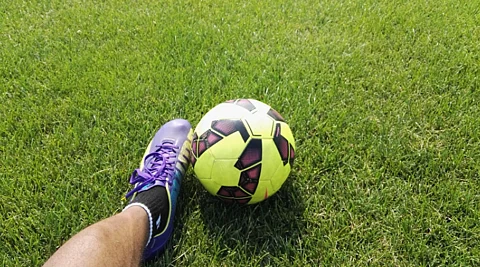

Football, known as soccer in some regions, enjoys immense popularity worldwide, captivating millions with its exciting matches and celebrated tournaments.
This popularity has catalyzed a burgeoning market for football gear, encompassing everything from footballs and apparel to protective equipment and training accessories.
Today, we’ll explore this market's dimensions, focusing on its size, growth drivers, and key trends.
The football gear market is not just growing; it's thriving. Fueled by the sport's global appeal and the expansion of professional leagues across continents, this market has reached billions in annual revenue. And the best part? It's not slowing down. Recent market analyses project a steady growth over the next decade, driven by increasing participation in football at grassroots and professional levels, growing consumer spending on sports apparel and advanced training equipment like football quarterback machines, and the rising popularity of women's football.
Globally, football reigns supreme as the most beloved sport, with its vast following encompassing billions of players and fans. The sport’s universal appeal drives demand for football gear, including apparel, footwear, and protective equipment.
Major global tournaments like the FIFA World Cup and UEFA Champions League dramatically increase gear sales, with enthusiasts and amateur athletes acquiring the latest merchandise to replicate their admired stars.
Technological advancements in football gear have led to the development of high-performance products that enhance player safety and performance. Innovations in materials and design, such as lightweight and breathable fabrics, shock-absorbing foams, and ergonomic designs, have made football gear more comfortable and effective. These advancements encourage players to invest in new equipment, further fueling market growth.
Youth participation in football is increasing, supported by grassroots initiatives and school programs. Governments and organizations worldwide are investing in football infrastructure and youth development programs, leading to a surge in demand for football gear. Parents are willing to spend on quality equipment to ensure their children's safety and improve their performance, contributing to market expansion.
Football apparel and footwear constitute the largest segment of the football gear market. This category includes jerseys, shorts, socks, and football boots. Professional and amateur players drive the demand for branded and high-performance apparel and footwear. Major brands like Nike, Adidas, and Puma dominate this segment, constantly innovating to provide better products and maintain their market share.
Protective equipment, such as shin guards, gloves, and helmets, is essential for player safety. The segment dedicated to safety gear is growing notably as more people recognize its importance. Innovations in protective equipment design and materials have enhanced their effectiveness, leading to higher adoption rates among players at all levels.
Training and performance gear, including training cones, agility ladders, and resistance bands, are crucial for player development. This segment is growing as teams and individual players focus more on fitness and skill improvement. The rise of professional training academies and fitness programs tailored for football players also drives the demand for these products.
North America is a significant market for football gear, particularly in the United States and Canada. The presence of prominent sports brands and the escalating enthusiasm for soccer among young and professional players are key drivers of the market in this region. Initiatives like Major League Soccer (MLS) expansion and increased youth participation contribute to the market's growth.
As football's traditional stronghold, Europe represents a substantial global football gear market share. Key contributors include the United Kingdom, Germany, Spain, and Italy. The presence of top football clubs and leagues, high participation rates, and strong fan culture drive the demand for football gear in Europe. The region also sees significant investment in football infrastructure and youth development programs.
As football gains popularity and economic conditions improve, the Asia-Pacific region is rapidly emerging as an important market for football gear. China, Japan, South Korea, and India are notably investing extensively in developing football from grassroots to professional levels. The rise of local leagues and international collaborations boost the market. Additionally, the growing middle class in this region is willing to spend on premium football gear, further propelling market growth.
Latin America has a deep-rooted football culture, with countries like Brazil and Argentina being football powerhouses. The passion for the sport translates into high demand for football gear. Both local manufacturing and international brands drive the region's market. Football academies and grassroots programs also expand, contributing to the market's growth.
The Middle East and Africa's football gear market is expanding, driven by increased football participation and enhanced sports infrastructure. Key markets that are affected by this growth include Qatar, the United Arab Emirates, and South Africa. Additionally, the upcoming FIFA World Cup in Qatar will likely increase demand for football gear. Moreover, efforts to develop local talent and leagues are driving demand for quality football equipment.
The football gear market is poised for substantial growth in the coming years, driven by the sport's global popularity, technological advancements, and increasing youth participation. Ultimately, as the market evolves, innovation and strategic investments will be key to capitalizing on the growing demand for football gear.
